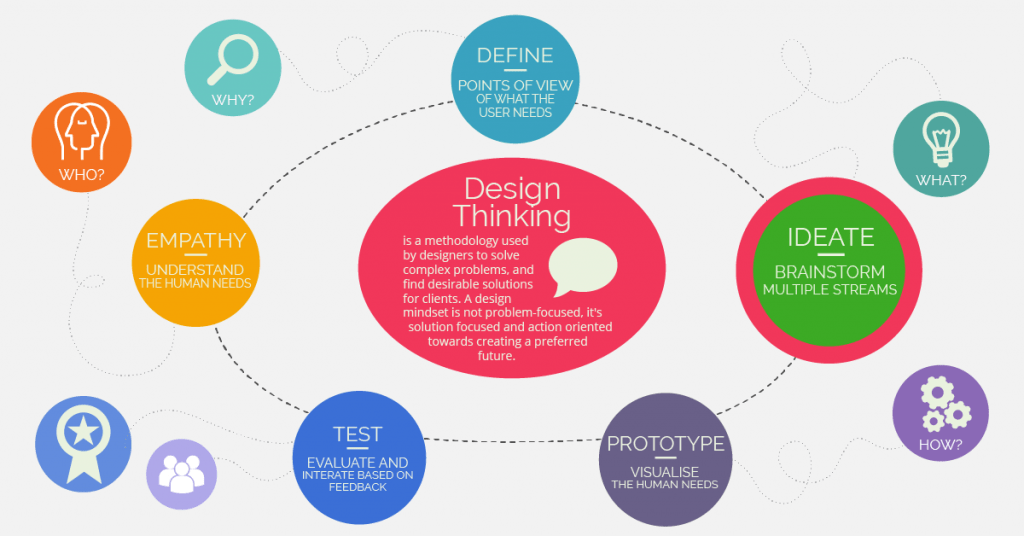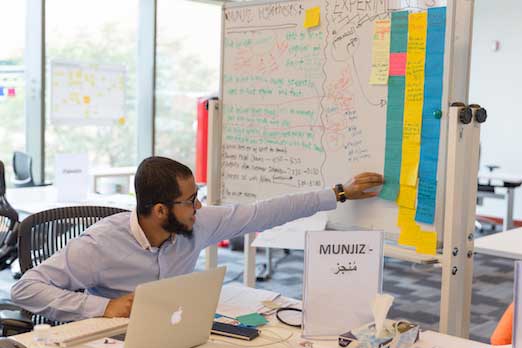This article is part of our KAUST Innovation Design Thinking series.This post focuses on the importance of the Ideation phase. Each article will focus on a core step of the Design Thinking process, including Empathize, Define, Ideate, Prototype, Testing, and Storytelling.
What makes a good idea? In this stage of the design thinking process: anything.
If you’re an entrepreneur waiting for a “lightbulb” or “eureka” idea, think again. The best ideas usually come from solutions that respond to a specific need in a group of users. Sure, you might have the start of a great idea, but it’s much easier to design a solution once you have defined the problem. If you don’t have a problem statement yet, go back to the Define stage of the Design Thinking process.
The ideation stage is the transition between identifying the problem and creating the solution. You start by generating a large number of ideas – from the obvious to the weird and wacky – and then work with your team to refine them.
“Ideation is the mode of the design process in which you concentrate on idea generation. Mentally it represents a process of “going wide” in terms of concepts and outcomes. Ideation provides both the fuel and also the source material for building prototypes and getting innovative solutions into the hands of your users.”
– d.school, An Introduction to Design Thinking Process Guide
1. How to develop an innovative idea
Begin with your How Might We (HMW) questions to kick-start different brainstorming ideas. This example of HMW questions from Stanford’s d.school illustrates this concept:
Challenge: Redesign the ground experience at the local international airport
POV: Harried mother of three, rushing through the airport only to wait hours at the gate, needs to entertain her playful children because “annoying little brats” only irritate already frustrated fellow passengers.
- Amp up the good: HMW use the kids’ energy to entertain fellow passenger?
- Remove the bad: HMW separate the kids from fellow passengers?
- Explore the opposite: HMW make the wait the most exciting part of the trip?
- Question an assumption: HMW entirely remove the wait time at the airport?
- Go after adjectives: HMW we make the rush refreshing instead of harrying?
- ID unexpected resources: HMW leverage free time of fellow passengers to share the load?
- Create an analogy from need or context: HMW make the airport like a spa? Like a playground?
- Play POV against the challenge: HMW make the airport a place that kids want to go?
- Change a status quo: HMW make playful, loud kids less annoying?
- Break POV into pieces: HMW entertain kids? HMW slow a mom down? HMW mollify delayed passengers
2. Start brainstorming
Once your team has outlined the questions they want to answer, you can start brainstorming a range of solutions to the problem. Brainstorming doesn’t have to be difficult, but it’s important to keep the process semi-structured and follow ground rules to avoid common pitfalls.
- Stay focused: Make sure that everyone in your brainstorming team is familiar with the outcomes of your empathize stage and defined goals. Use your HMW questions to remain on topic and avoid getting bogged down in the details of a solution.
- Defer judgment and criticism: Essential to a good brainstorming phase is to reserve or hold off any judgment. In this session, all team members are equal and should feel comfortable voicing their ideas. To avoid anxiety, start with an icebreaker like Worst Possible Idea.
- Encourage free thinking: This is a creative activity, and the goal is to come up with as many ideas as possible. Avoid idea killers like, “Yes…but,” “There’s no budget…” “The market is not ready…” etc. Print this poster and post it during your ideation session. Ensure that your facilitator keeps the session positive by having the team postpone their judgements until it comes time to challenge the new ideas.
- Quantity over quality: Come up with as many solutions as possible. Don’t cut your session short when you have a few good ideas.
- Be visual: This is not a session to be serious and boring. Keep the creative juices flowing by making sure you’re in a friendly and creative space. Write down all ideas on post-its or a whiteboard and use drawings or doodles as tools to help spark the imagination.
To get started check out this brainstorming “how to” video from IDEO’s Toy Lab.
3. Select an idea
After your ideation session, you should have a laundry list of ideas that need to be grouped and categorized into a shortlist. The simplest method for this is by dot voting. To do this, ask all team members to vote (3 or 4 votes is usually enough) for an idea they like with a sticker dot or pen mark. Another technique is the four categories method – grouping ideas from most rational to long shot. If you’re stuck selecting an idea, there are many more techniques to get you started before you move on to prototyping.
Remember, Design Thinking is not a linear process. Your ideation session may have sparked new insights and require you to circle back and tweak or redefine your problem. Or you may want to return to the empathize stage to reassess your idea against your user’s needs. As Thomas Edison once said, “Genius is one percent inspiration and ninety-nine percent perspiration.”
This series is part of our focus on Design Thinking, find all the articles in the series below:
Part 1: Why your company needs Design Thinking!
Part 2 – Empathize: How to know what your customers really want
Part 3 – Define: Can you define your startup in one sentence?
Part 4 – Ideate: What makes a good startup idea?
Paty 5 – Prototype: Why and how to use prototypes


